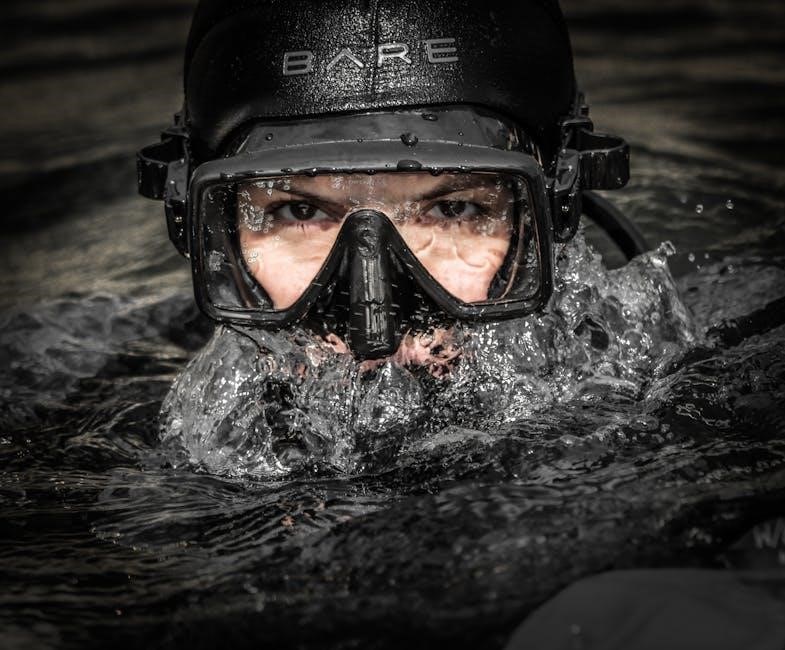navy dive manual
Category : Manuals
The Navy Dive Manual provides comprehensive guidelines for safe and effective diving operations‚ detailing procedures‚ equipment‚ and safety protocols essential for naval diving missions and training.
Overview of the Manual’s Purpose
The Navy Dive Manual is a critical resource that outlines safety protocols‚ operational guidelines‚ and best practices for naval diving operations. Its primary purpose is to ensure the safety of divers‚ support personnel‚ and equipment during various underwater missions. The manual covers a wide range of topics‚ including pre-dive checks‚ emergency procedures‚ and equipment maintenance. It serves as a comprehensive guide for training‚ certification‚ and mission execution‚ ensuring adherence to strict safety standards. By standardizing procedures‚ the manual helps mitigate risks and enhances the effectiveness of naval diving operations. It is regularly updated to reflect advancements in technology and operational demands.

Types of Diving Operations
The Navy Dive Manual details various diving operations‚ including surface-supplied‚ scuba‚ submarine escape‚ salvage‚ and special missions‚ each requiring unique techniques and safety protocols.
Surface-Supplied Diving Operations
Surface-supplied diving operations involve the use of compressed air or mixed-gas systems‚ where breathing gas is supplied from the surface via an umbilical hose. These operations are typically conducted in shallower depths and are ideal for tasks requiring extended bottom time. The system allows for real-time communication between the diver and the surface support team‚ enhancing safety. Depth limits are carefully calculated to avoid excessive pressure exposure‚ and divers undergo rigorous training to handle the equipment and potential hazards. Regular maintenance of the umbilical hose‚ helmet‚ and air supply system is critical to ensure safe and efficient operations. These procedures are detailed in the Navy Dive Manual to meet the demands of various missions while minimizing risks to divers. Post-dive documentation is also emphasized to record operational details and ensure accountability. This method is widely used for salvage‚ recovery‚ and underwater construction tasks‚ making it a cornerstone of naval diving operations. The manual also highlights the importance of line-pull signals for communication between divers and tenders‚ ensuring seamless coordination during operations. By adhering to these guidelines‚ the U.S. Navy ensures that surface-supplied diving operations remain safe and effective‚ enabling divers to perform critical missions with precision and confidence. The evolution of these techniques has allowed the Navy to expand its operational capabilities‚ supporting both military and humanitarian efforts worldwide. As technology advances‚ the Navy continues to refine its surface-supplied diving protocols to address new challenges and improve diver safety. This commitment to excellence is reflected in the comprehensive procedures outlined in the Navy Dive Manual‚ making it an indispensable resource for all diving operations. The manual also serves as a historical record of the advancements in diving technology and practices‚ providing valuable insights for future generations of Navy divers. By prioritizing safety‚ efficiency‚ and adaptability‚ the Navy Dive Manual ensures that surface-supplied diving operations remain a vital component of naval capabilities. The detailed guidelines and protocols outlined in the manual are designed to prepare divers for the physical and mental demands of these operations‚ ensuring they can operate effectively in diverse and challenging environments. The emphasis on proper equipment maintenance and communication procedures underscores the Navy’s dedication to minimizing risks and maximizing operational success. Through rigorous training and adherence to the manual’s guidelines‚ Navy divers are equipped to handle the complexities of surface-supplied diving operations‚ contributing to the success of various missions and upholding the highest standards of safety and professionalism. The Navy Dive Manual is a testament to the Navy’s commitment to excellence in diving operations‚ providing a foundation for continuous improvement and innovation in this critical field. By staying aligned with the manual’s principles‚ Navy divers can confidently undertake surface-supplied diving operations‚ knowing they have the support of a robust and proven system. The manual’s focus on teamwork‚ safety‚ and precision ensures that every operation is conducted with the utmost care and effectiveness‚ reflecting the Navy’s unwavering dedication to its personnel and missions. Surface-supplied diving operations are just one example of how the Navy Dive Manual empower divers to achieve exceptional results in demanding environments. The manual’s comprehensive approach to these operations serves as a model for other naval programs‚ demonstrating the importance of detailed planning‚ rigorous training‚ and continuous improvement. By leveraging the guidelines and best practices outlined in the Navy Dive Manual‚ the Navy continues to set the standard for safe and successful diving operations worldwide. This commitment to excellence ensures that Navy divers are always prepared to meet the challenges of their missions‚ whether in combat‚ salvage‚ or humanitarian operations. The Navy Dive Manual is an essential tool in this endeavor‚ providing the knowledge and protocols necessary to conduct surface-supplied diving operations with precision and safety. As the Navy moves forward‚ the manual will remain a cornerstone of its diving programs‚ guiding generations of divers and ensuring the continued success of naval operations. The detailed procedures and safety protocols outlined in the manual are designed to adapt to evolving challenges‚ ensuring that Navy divers remain at the forefront of diving technology and techniques. By staying true to the principles of the Navy Dive Manual‚ the Navy’s diving operations will continue to excel‚ supporting national security and global stability with unmatched expertise and professionalism. The manual’s emphasis on teamwork‚ communication‚ and safety ensures that every surface-supplied diving operation is conducted with the highest level of efficiency and effectiveness‚ reflecting the Navy’s commitment to operational excellence. As the Navy faces new challenges in the 21st century‚ the Navy Dive Manual will remain a vital resource‚ enabling divers to perform their duties with confidence and precision. The manual’s comprehensive coverage of surface-supplied diving operations is just one aspect of its broader mission to provide the U.S. Navy with the tools and knowledge needed to excel in all aspects of diving. By adhering to the manual’s guidelines‚ Navy divers can overcome any obstacle‚ ensuring the success of their missions and the safety of their team. The Navy Dive Manual is more than just a guide; it is a symbol of the Navy’s dedication to excellence and its commitment to the well-being of its divers. Through its detailed procedures and emphasis on safety‚ the manual ensures that surface-supplied diving operations are conducted with the utmost care and professionalism. As the Navy continues to evolve‚ the manual will serve as a foundation for future advancements in diving technology and practices‚ ensuring that Navy divers remain at the forefront of their field. The Navy Dive Manual is a testament to the Navy’s enduring commitment to safety‚ innovation‚ and operational excellence‚ making it an indispensable resource for all diving operations. By following the manual’s guidelines‚ Navy divers can confidently undertake surface-supplied diving operations‚ knowing they are supported by a robust and proven system. The manual’s focus on safety‚ efficiency‚ and teamwork ensures that every operation is conducted with the highest standards of professionalism and care‚ reflecting the Navy’s unwavering dedication to its personnel and missions. Surface-supplied diving operations are a critical component of the Navy’s capabilities‚ and the Navy Dive Manual provides the essential knowledge and protocols needed to perform these operations safely and effectively. The manual’s comprehensive approach to diving operations ensures that Navy divers are always prepared to meet the challenges of their missions‚ whether in combat‚ salvage‚ or humanitarian operations. By leveraging the guidelines and best practices outlined in the Navy Dive Manual‚ the Navy continues to set the standard for safe and successful diving operations worldwide. This commitment to excellence ensures that Navy divers are always prepared to meet the challenges of their missions‚ whether in combat‚ salvage‚ or humanitarian operations. The Navy Dive Manual is an essential tool in this endeavor‚ providing the knowledge and protocols necessary to conduct surface-supplied diving operations with precision and safety. As the Navy moves forward‚ the manual will remain a cornerstone of its diving programs‚ guiding generations of divers and ensuring the continued success of naval operations. The detailed procedures and safety protocols outlined in the manual are designed to adapt to evolving challenges‚ ensuring that Navy divers remain at the forefront of diving technology and techniques. By staying true to the principles of the Navy Dive Manual‚ the Navy’s diving operations will continue to excel‚ supporting national security and global stability with unmatched expertise and professionalism. The manual’s emphasis on teamwork‚ communication‚ and safety ensures that every surface-supplied diving operation is conducted with the highest level of efficiency and effectiveness‚ reflecting the Navy’s commitment to operational excellence. As the Navy faces new challenges in the 21st century‚ the Navy Dive Manual will remain a vital resource‚ enabling divers to perform their duties with confidence and precision. The manual’s comprehensive coverage of surface-supplied diving operations is just one aspect of its broader mission to provide the U.S. Navy with the tools and knowledge needed to excel in all aspects of diving. By adhering to the manual’s guidelines‚ Navy divers can overcome any obstacle‚ ensuring the success of their missions and the safety of their team. The Navy Dive Manual is more than just a guide; it is a symbol of the Navy’s dedication to excellence and its commitment to the well-being of its divers. Through its detailed procedures and emphasis on safety‚ the manual ensures that surface-supplied diving operations are conducted with the utmost care and professionalism. As the Navy continues to evolve‚ the manual will serve as a foundation for future advancements in diving technology and practices‚ ensuring that Navy divers remain at the forefront of their field. The Navy Dive Manual is a testament to the Navy’s enduring commitment to safety‚ innovation‚ and operational excellence‚ making it an indispensable resource for all diving operations. By following the manual’s guidelines‚ Navy divers can confidently undertake surface-supplied diving operations‚ knowing they are supported by a robust and proven system. The manual’s focus on safety‚ efficiency
Scuba Diving Operations

Scuba diving operations rely on self-contained breathing apparatuses‚ allowing divers to operate independently without surface-supplied air. These operations are ideal for missions requiring greater mobility‚ such as underwater reconnaissance‚ special operations‚ and search and recovery. Scuba divers undergo specialized training to navigate effectively and communicate underwater. The Navy Dive Manual outlines procedures for equipment setup‚ depth limits‚ and buddy checks to ensure safety. Scuba operations are highly versatile but require precise planning‚ as air supply is limited. Divers must also manage buoyancy and monitor their surroundings to avoid hazards. The manual emphasizes the importance of pre-dive briefings and post-dive debriefings to ensure mission success and diver safety. Proper equipment maintenance and adherence to established protocols are critical for scuba operations‚ enabling divers to perform effectively in diverse environments. The manual also covers emergency procedures‚ such as air supply management and underwater rescue techniques‚ ensuring divers are prepared for unexpected situations. Scuba diving operations are a vital component of naval capabilities‚ providing flexibility and autonomy for a wide range of missions. By following the Navy Dive Manual’s guidelines‚ divers can execute these operations with precision and confidence‚ upholding the Navy’s high standards of safety and professionalism. The manual’s detailed instructions ensure that scuba diving operations are conducted efficiently‚ while minimizing risks to personnel and equipment. This approach allows the Navy to maintain its operational readiness and effectiveness in various scenarios‚ from combat to humanitarian missions. Scuba diving operations are a testament to the Navy’s adaptability and commitment to excellence‚ as outlined in the Navy Dive Manual. By adhering to the manual’s principles‚ Navy divers can overcome challenges and achieve their objectives with utmost efficiency. The Navy Dive Manual serves as a comprehensive guide for scuba diving operations‚ providing the necessary tools and knowledge for divers to excel in their roles. Through rigorous training and adherence to the manual’s protocols‚ Navy divers are well-prepared to handle the complexities of scuba diving operations‚ ensuring the success of their missions and the safety of their team. The manual’s focus on precision‚ safety‚ and adaptability makes it an indispensable resource for scuba diving operations‚ enabling the Navy to meet the demands of modern maritime operations. By staying aligned with the manual’s guidelines‚ Navy divers can confidently undertake scuba diving operations‚ knowing they are supported by a robust and proven system. The Navy Dive Manual is a cornerstone of naval diving operations‚ providing the foundation for continuous improvement and innovation in this critical field. Scuba diving operations are just one example of how the manual empowers divers to achieve exceptional results in challenging environments. The manual’s comprehensive approach ensures that every scuba diving operation is conducted with the utmost care and effectiveness‚ reflecting the Navy’s unwavering dedication to its personnel and missions. As the Navy continues to evolve‚ the manual will remain a vital resource‚ guiding divers through the complexities of scuba diving operations and ensuring their success. The detailed procedures and safety protocols outlined in the manual are designed to adapt to new challenges‚ ensuring that Navy divers remain at the forefront of diving technology and techniques. By staying true to the principles of the Navy Dive Manual‚ the Navy’s scuba diving operations will continue to excel‚ supporting national security and global stability with unmatched expertise and professionalism. The manual’s emphasis on teamwork‚ communication‚ and safety ensures that every scuba diving operation is conducted with the highest level of efficiency and effectiveness‚ reflecting the Navy’s commitment to operational excellence. As the Navy faces new challenges in the 21st century‚ the Navy Dive Manual will remain a vital resource‚ enabling divers to perform their duties with confidence and precision. The manual’s comprehensive coverage of scuba diving operations is just one aspect of its broader mission to provide the U.S. Navy with the tools and knowledge needed to excel in all aspects of diving. By adhering to the manual’s guidelines‚ Navy divers can overcome any obstacle‚ ensuring the success of their missions and the safety of their team. The Navy Dive Manual is more than just a guide; it is a symbol of the Navy’s dedication to excellence and its commitment to the well-being of its divers. Through its detailed procedures and emphasis on safety‚ the manual ensures that scuba diving operations are conducted with the utmost care and professionalism. As the Navy continues to evolve‚ the manual will serve as a foundation for future advancements in diving technology and practices‚ ensuring that Navy divers remain at the forefront of their field. The Navy Dive Manual is a testament to the Navy’s enduring commitment to safety‚ innovation‚ and operational excellence‚ making it an indispensable resource for all diving operations. By following the manual’s guidelines‚ Navy divers can confidently undertake scuba diving operations‚ knowing they are supported by a robust and proven system. The manual’s focus on safety‚ efficiency‚ and teamwork ensures that every operation is conducted with the highest standards of professionalism and care‚ reflecting the Navy’s unwavering dedication to its personnel and missions. Scuba diving operations are a critical component of the Navy’s capabilities‚ and the Navy Dive Manual provides the essential knowledge and protocols needed to perform these operations safely and effectively. The manual’s comprehensive approach to diving operations ensures that Navy divers are always prepared to meet the challenges of their missions‚ whether in combat‚ salvage‚ or humanitarian operations. By leveraging the guidelines and best practices outlined in the Navy Dive Manual‚ the Navy continues to set the standard for safe and successful diving operations worldwide. This commitment to excellence ensures that Navy divers are always prepared to meet the challenges of their missions‚ whether in combat‚ salvage‚ or humanitarian operations. The Navy Dive Manual is an essential tool in this endeavor‚ providing the knowledge and protocols necessary to conduct scuba diving operations with precision and safety. As the Navy moves forward‚ the manual will remain a cornerstone of its diving programs‚ guiding generations of divers and ensuring the continued success of naval operations. The detailed procedures and safety protocols outlined in the manual are designed to adapt to evolving challenges‚ ensuring that Navy divers remain at the forefront of diving technology and techniques. By staying true to the principles of the Navy Dive Manual‚ the Navy’s diving operations will continue to excel‚ supporting national security and global stability with unmatched expertise and professionalism. The manual’s emphasis on teamwork‚ communication‚ and safety ensures that every scuba diving operation is conducted with the highest level of efficiency and effectiveness‚ reflecting the Navy’s commitment to operational excellence. As the Navy faces new challenges in the 21st century‚ the Navy Dive Manual will remain a vital resource‚ enabling divers to perform their duties with confidence and precision. The manual’s comprehensive coverage of scuba diving operations is just one aspect of its broader mission to provide the U.S. Navy with the tools and knowledge needed to excel in all aspects of diving. By adhering to the manual’s guidelines‚ Navy divers can overcome any obstacle‚ ensuring the success of their missions and the safety of their team. The Navy Dive Manual is more than just a guide; it is a symbol of the Navy’s dedication to excellence and its commitment to the well-being of its divers. Through its detailed procedures and emphasis on safety‚ the manual ensures that scuba diving operations are conducted with the utmost care and professionalism. As the Navy continues to evolve‚ the manual will serve as a foundation for future advancements in diving technology and practices‚ ensuring that Navy divers remain at the forefront of their field. The Navy Dive Manual is a testament to the Navy’s enduring commitment to safety‚ innovation‚ and operational excellence‚ making it an indispensable resource for all diving operations. By following the manual’s guidelines‚ Navy divers can confidently undertake scuba diving operations‚ knowing they are supported by a robust and proven system. The manual’s focus on safety‚ efficiency‚ and teamwork ensures that every operation is conducted with the highest standards of professionalism and care‚ reflecting the Navy’s unwavering dedication to its personnel and missions. Scuba diving operations are a critical component of the Navy’s capabilities‚ and the Navy Dive Manual provides the essential knowledge and protocols needed to perform these operations safely and effectively. The manual’s comprehensive approach to diving operations ensures that Navy divers are always prepared to meet the challenges of their missions‚ whether in combat‚ salvage‚ or humanitarian operations. By leveraging the guidelines and best practices
Submarine Escape Procedures
Submarine escape procedures are critical for sailors to safely exit a submerged submarine in emergencies. The Navy Dive Manual details methods like the “free ascent” and “escape trunk” techniques. Divers must equalize pressure‚ avoid rapid ascent‚ and use emergency breathing apparatuses. Training emphasizes controlled breathing‚ buoyancy management‚ and staying calm. The manual also covers post-escape protocols‚ such as marking the location and awaiting rescue. These procedures ensure crew survival‚ even in extreme depths. Proper execution requires physical fitness‚ mental preparedness‚ and adherence to established guidelines. The manual stresses the importance of regular drills to maintain proficiency in escape techniques.
Salvage and Recovery Operations
Salvage and recovery operations involve retrieving submerged objects‚ vehicles‚ or debris‚ ensuring maritime safety and environmental protection. The Navy Dive Manual outlines procedures for planning‚ executing‚ and securing such operations. Divers must assess underwater conditions‚ use specialized equipment like ROVs‚ and employ lifting techniques. Safety protocols include monitoring water depth‚ current strength‚ and object stability. Post-recovery‚ teams conduct debriefings to evaluate mission success and identify improvements. These operations require precise coordination between divers‚ support crews‚ and engineers to minimize risks and achieve efficient recovery. The manual emphasizes adherence to safety standards and environmental regulations throughout the process.
Special Operations and Missions
Special operations and missions encompass high-risk‚ classified‚ or unconventional tasks requiring advanced diving skills. These include counterterrorism‚ explosive ordnance disposal‚ and covert reconnaissance. The Navy Dive Manual details protocols for mission planning‚ equipment selection‚ and team coordination. Divers must adapt to unpredictable environments and utilize specialized gear‚ such as rebreathers and tactical communication systems. These operations often involve collaboration with other military units and require precise execution to achieve strategic objectives. The manual emphasizes the importance of secrecy‚ adaptability‚ and rigorous training to ensure mission success and operator safety in these unique scenarios.

Safety Protocols and Procedures
Safety protocols and procedures in the Navy Dive Manual emphasize adherence to established guidelines‚ thorough risk assessments‚ and emergency preparedness to ensure diver safety.

Pre-Dive Safety Checks

Pre-dive safety checks are critical to ensure all equipment functions properly and divers are prepared for the operation. These checks include inspecting diving gear‚ testing life support systems‚ and verifying communication devices. Buddy checks are mandatory to confirm that each diver’s equipment is secure and functioning correctly. Environmental assessments‚ such as water temperature and visibility‚ are also conducted to identify potential risks. Additionally‚ divers review their mission plan and emergency procedures to ensure readiness. These systematic checks minimize risks and ensure a safe diving operation.
In-Water Safety Guidelines

In-water safety guidelines are essential to ensure diver safety during operations. Divers must continuously monitor their air supply‚ depth‚ and surrounding environment. Buddy diving is mandatory‚ with each diver responsible for their partner’s safety. Clear communication through hand signals or electronic devices is critical. Divers should avoid exceeding safe depth limits and stay within planned timeframes. Regular safety stops are required to prevent decompression sickness. Additionally‚ divers must remain vigilant for hazards such as strong currents or marine life. Adhering to these guidelines minimizes risks and enhances the overall safety of the diving mission.

Post-Dive Safety Procedures
Post-dive safety procedures are critical to ensure diver well-being and mission success. Upon surfacing‚ divers must immediately report to the dive supervisor for accountability. A thorough equipment inspection is conducted to identify any damage or malfunctions. Divers must undergo a post-dive safety check by a dive medic to assess for signs of decompression sickness or other diving-related injuries. All gear is then secured and stowed properly to prevent loss or damage. Documentation of the dive‚ including any incidents‚ is completed and filed for future reference. These steps ensure safety and readiness for subsequent operations.
Emergency Procedures
Emergency procedures in the Navy Dive Manual ensure rapid response to critical situations‚ emphasizing clear communication‚ immediate action‚ and adherence to established safety protocols to minimize risks.
Oxygen Administration in Emergencies
Oxygen administration is crucial in navy diving emergencies to prevent hypoxia and aid recovery. The Navy Dive Manual provides protocols for emergency oxygen use‚ emphasizing proper setup and use of oxygen tanks‚ regulators‚ and delivery systems. Divers must recognize symptoms like decompression sickness‚ oxygen toxicity‚ or respiratory distress and deliver oxygen safely. Correct flow rates and durations are vital; over-administration can cause further complications. Immediate action and adherence to manual guidelines ensure effective treatment and improve outcomes in critical diving situations‚ making it a cornerstone of emergency response.
Air Supply Management During Emergencies
Air supply management is critical during diving emergencies to ensure diver survival and operational efficiency. The Navy Dive Manual outlines procedures for monitoring air reserves‚ conserving supply‚ and redistributing air when necessary; Divers and support teams must communicate clearly to assess air levels and prioritize usage. Emergency protocols include isolating air leaks‚ switching to backup supplies‚ and coordinating surface support. Proper management prevents air starvation‚ extends dive duration‚ and maintains team safety‚ ensuring effective emergency resolution and recovery operations in critical underwater scenarios.
Decompression Sickness Treatment
Decompression sickness (DCS) occurs when rapid pressure changes cause gas bubbles in the bloodstream. The Navy Dive Manual emphasizes immediate medical attention‚ with recompression therapy as the primary treatment. Hyperbaric chambers are used to gradually reduce pressure‚ alleviating symptoms like joint pain or respiratory distress. Oxygen administration is critical to stabilize the diver and prevent further complications. Medical personnel must follow strict protocols to manage DCS effectively‚ ensuring the diver’s safe recovery and preventing long-term damage. Prompt treatment is essential to avoid severe health consequences and restore diving readiness.

Underwater Rescue Operations
Underwater rescue operations are critical in emergencies‚ requiring precise coordination and trained personnel. The Navy Dive Manual outlines procedures for rescuing distressed divers‚ emphasizing safety and efficiency. Rescue teams use specialized equipment‚ such as rescue lines and underwater communication devices‚ to locate and assist divers in distress. Operations are planned meticulously to minimize risks to both rescuers and the diver in need. The primary goal is to stabilize the situation‚ provide medical support if necessary‚ and ensure a safe recovery. These protocols are designed to protect lives while maintaining operational integrity and adherence to safety standards.

Equipment and Gear
Navy diving operations rely on a variety of specialized equipment‚ including personal gear‚ support systems‚ and advanced tools‚ all critical for ensuring safety and operational effectiveness underwater.
Personal Diving Equipment
Personal diving equipment is essential for Navy divers to ensure safety and operational effectiveness. This includes diving helmets‚ full-face masks‚ and breathing apparatuses that provide reliable air supply. Exposure suits‚ such as wetsuits or dry suits‚ protect divers from cold water and environmental hazards. Gloves‚ boots‚ and weight belts are also critical for mobility and stability underwater. Additionally‚ buoyancy compensators and life support systems are integral for maintaining proper depth and comfort during dives. Each piece of equipment is carefully selected to meet mission requirements and ensure diver safety in various operational conditions.
Support and Auxiliary Equipment
Support and auxiliary equipment play a crucial role in Navy diving operations‚ enhancing safety and efficiency. This includes air compressors for filling scuba tanks‚ storage systems for securing gear‚ and communication devices for real-time coordination. Auxiliary equipment such as underwater lights‚ tools for salvage operations‚ and rescue gear are also essential. These items ensure divers can perform tasks effectively while maintaining operational readiness. Proper use and maintenance of support equipment are critical to the success of diving missions and the safety of the dive team in various operational scenarios.
Equipment Maintenance and Inspection
Regular maintenance and inspection of diving equipment are critical to ensure safety and reliability. All gear must be checked before and after each dive‚ with special attention to hoses‚ valves‚ and O-rings. A detailed inspection checklist is used to verify the condition of regulators‚ cylinders‚ and other components. Testing of equipment‚ such as pressure-holding tests for scuba tanks‚ is mandatory. Any damaged or worn-out parts must be replaced promptly‚ adhering to Navy standards. Proper storage and cleaning of equipment are also essential to prevent corrosion and maintain functionality‚ ensuring readiness for future operations.
Training and Certification
Navy diving training ensures personnel master underwater operations‚ safety protocols‚ and emergency procedures. Certification requires rigorous testing‚ emphasizing physical endurance‚ mental resilience‚ and adherence to operational standards.
Basic Diving Training
Basic diving training introduces sailors to fundamental diving skills‚ safety protocols‚ and equipment operation; Classroom instruction covers diving physics‚ physiology‚ and emergency procedures. Trainees progress to confined water exercises‚ mastering breathing techniques‚ buoyancy control‚ and underwater communication. Open-water training follows‚ where divers apply skills in real-world conditions‚ focusing on navigation‚ depth management‚ and teamwork. Emphasis is placed on safety‚ equipment maintenance‚ and adaptability to varying underwater environments. Successful completion prepares divers for advanced training and operational readiness in naval diving missions.
Advanced Diving Techniques
Advanced diving techniques focus on specialized skills for complex underwater operations. Training includes wreck diving‚ underwater search patterns‚ and advanced navigation methods. Divers learn to operate specialized equipment‚ such as underwater cutting tools and hydraulic systems. Emphasis is placed on managing challenging conditions‚ like strong currents or limited visibility. Techniques for conducting night dives and operating in contaminated water are also covered. Advanced training prepares divers for high-risk missions‚ ensuring they can handle emergencies and adapt to unpredictable environments. These skills are essential for real-world naval diving operations and special missions.
